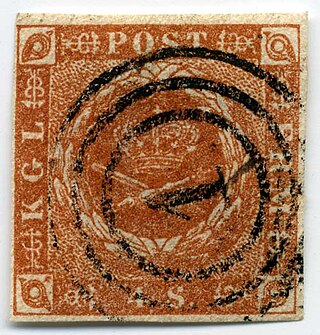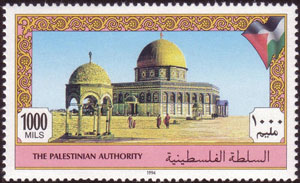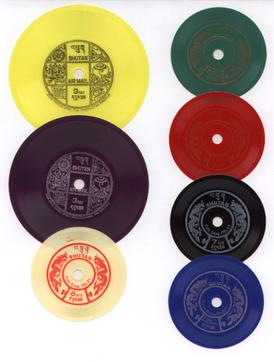
A postage stamp is a small piece of paper issued by a post office, postal administration, or other authorized vendors to customers who pay postage. Then the stamp is affixed to the face or address-side of any item of mail—an envelope or other postal cover —which they wish to send. The item is then processed by the postal system, where a postmark or cancellation mark—in modern usage indicating date and point of origin of mailing—is applied to the stamp and its left and right sides to prevent its reuse. Next the item is delivered to its addressee.

Indian postal systems for efficient military and governmental communications had developed long before the arrival of Europeans. When the Portuguese, Dutch, French, Danish and British conquered the Marathas who had already defeated the Mughals, their postal systems existed alongside those of many somewhat independent states. The British East India Company gradually annexed the other powers on the sub-continent and brought into existence a British administrative system over most of modern-day India, with a need to establish and maintain both official and commercial mail systems.

This is an overview of the postage stamps and postal history of Denmark.
This is a survey of the postage stamps and postal history of Afghanistan.

Postage stamps and postal history of Great Britain surveys postal history from the United Kingdom and the postage stamps issued by that country and its various historical territories until the present day.

This is a survey of the postage stamps and postal history of the Russian Empire, the Soviet Union and the modern Russian Federation.

The history of the postage stamps and postal history of China is complicated by the gradual decay of Imperial China and the years of civil war and Japanese occupation in the 1930s and 1940s. In modern times, postal delivery is handled by China Post.

Postage stamp design is the activity of graphic design as applied to postage stamps. Many thousands of designs have been created since a profile bust of Queen Victoria was adopted for the Penny Black in 1840; some designs have been considered very successful, others less so.
This is a survey of the postage stamps and postal history of Hong Kong.

The United Nations Postal Administration (UNPA) is the postal agency of the United Nations. It issues postage stamps and postal stationery, denominated in United States dollars for the office in New York, in Swiss francs for the office in Geneva and in euros for the office in Vienna. As such, UNPA is the only postal authority that issues stamps in three different currencies.
Country definitives, formerly known as regional postage stamps of Great Britain, are the postage stamps issued for regions of the United Kingdom, reflecting the regional identity of the various countries and islands of the British isles.

The postal history of Malta began in the early modern period, when pre-adhesive mail was delivered to foreign destinations by privately owned ships for a fee. The earliest known letter from Malta, sent during the rule of the Order of St John, is dated 1532. The first formal postal service on the islands was established by the Order in 1708, with the post office being located at the Casa del Commun Tesoro in Valletta. The first postal markings on mail appeared later on in the 18th century.

The Palestinian National Authority began in 1994 to issue stamps and operate postal services as authorized by the Oslo Accords.

The postal history of Turkey and its predecessor state, the Ottoman Empire, dates to the 18th century when foreign countries maintained courier services through their consular offices in the Empire. Although delayed in the development of its own postal service, in 1863 the Ottoman Empire became the second independent country in Asia to issue adhesive postage stamps, and in 1875, it became a founding member of the General Postal Union, soon to become the Universal Postal Union. The Ottoman Empire became the Republic of Turkey in 1923, and in the following years, its postal service became more modernized and efficient and its postage stamps expertly designed and manufactured.

Nepal has a long postal history. The modern form of postal service was started by the Rana Prime minister Ranaudip Singh in 1878. He established the first post office which was named Nepal Hulak Ghar. In 1881, the first postal stamp was issued. As of 2020, about 1367 types of postal stamps have been issued. Currently, the postal service is regulated by the Postal act of Nepal. Nepal Post, locally known as Hulak Sewa(Nepali: हुलाक सेवा विभाग) or Daak Sewa(Nepali: डाँक सेवा) under the Ministry of Information and Communications is responsible for the postal service in Nepal.

The first postage stamps of Bhutan were issued in 1962, the same year that the first motorable road was opened. Before that there was a mail delivery system in place for official mail using mail runners, and between 1955 and 1962 revenue stamps were accepted as payment for internal mail. With the opening up of Bhutan in the early 1960s, a formal postal system was introduced.

This is a survey of the postage stamps and early postal history of Sudan. Sudan was governed by the United Kingdom and Egypt from 1898. Independence was proclaimed on 1 January, 1956, and independent Sudan became a member of the Universal Postal Union (UPU) on 27 July 1956.

Postage stamps and postal history of Singapore surveys postal history from Singapore and the postage stamps issued by that country and its various historical territories until the present day. Postal service in Singapore began with the delivery of stampless letters whose cost was borne by the receiving person, later encompassed pre-paid letters carried by private mail carriers and provisional post offices, and culminated in a system of universal prepayment that required all letters to bear nationally issued adhesive postage stamps. Singapore is an island country off maritime Southeast Asia, located between the Straits of Malacca and the South China Sea.

This is a survey of the postage stamps and postal history of Ethiopia. Long an independent state in Africa, messages were originally carried by couriers called méléktegnas, who held the letters attached to a stick.

The U.S. Parcel Post stamps of 1912–13 were the first such stamps issued by the U.S. Post Office Department and consisted of twelve denominations to pay the postage on parcels weighing 16 ounces and more, with each denomination printed in the same color of "carmine-rose". Their border design was similar while each denomination of stamp bore its own distinctive image in the center (vignette). Unlike regular postage items, whose rates were determined by weight in ounces, Parcel Post rates were determined and measured by increments in pounds. The new stamps were soon widely used by industry, farmers and others who lived in rural areas. Partly owing to some confusion involving their usage, their exclusive use as Parcel Post stamps proved short lived, as regular postage stamps were soon allowed to be used to pay parcel postage rates.




























